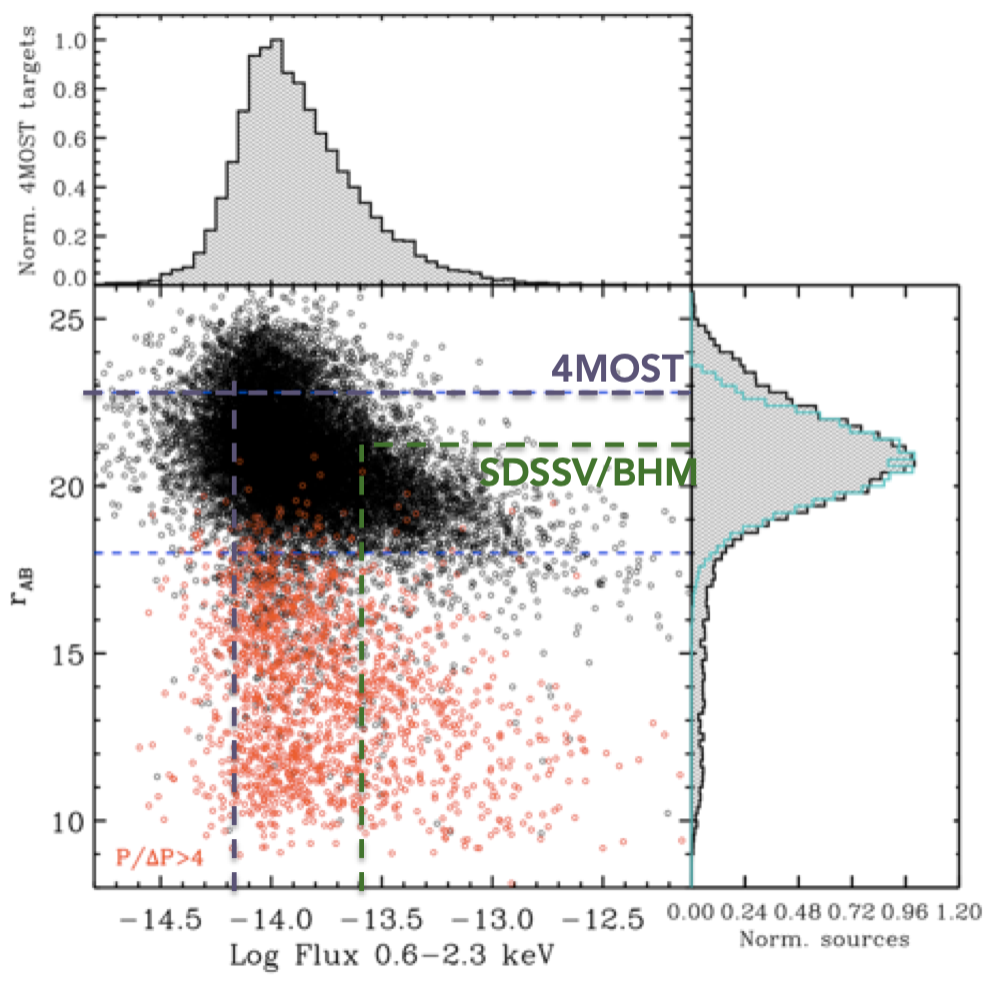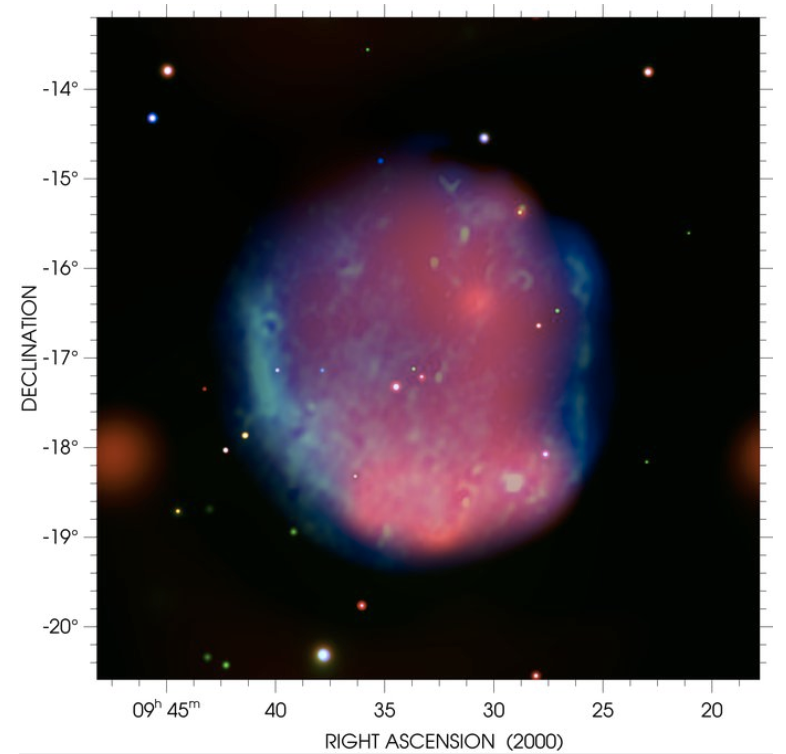IMPRS projects at MPE/HEG
|
The High Energy Astrophysics group at MPE has its major scientific emphasis on the study of extreme processes mostly via X-ray observations, but also extends to other wavebands. Our main astrophysical themes are: 1.) Large scale structure, as probed hot gas in clusters and groups of galaxies, and the related cosmological implications; 2.) The cosmic history of black hole growth and its relationship to galaxy evolution; 3.)Investigating physical processes including strong gravity around black holes and other compact objects; 4.) gamma-ray bursts. Research fields for which PhD projects are offered specifically for 2022 include: |
|
Tracing large scale structure with AGN: SDSS and 4MOST optical spectroscopy of eROSITA sources
Since December 2019 the SRG/eROSITA X-ray telescope is performing the deepest survey of the entire sky, with hundreds of thousands new accreting supermassive black holes being discovered every year. Starting in 2022 and 2023, respectively, the SDSS-V “Black Hole Mapper” and the 4MOST multi-object spectroscopic survey will obtain optical spectra of the majority of eROSITA detected AGN, providing a highly complete optical spectroscopic census of accreting black holes shining in X-rays. The combination of eROSITA and SDSS-V and 4MOST data will allow us to constrain the physics of AGN activation, their cosmic evolution and clustering properties, and explore the connection between AGN and large-scale structure up to z~6. The PhD project will be focused on the design, validation, execution and scientific exploitation of the most comprehensive multi-object spectroscopic surveys of active galactic nuclei to be carried out as part of the SDSS-V and 4MOST programs. Supervisors: A. Merloni, K. Nandra |

|
|
The co-evolution of super-massive black holes and their host galaxies
Super-massive black holes (SMBHs) rapidly growing in active galactic nuclei (AGN) are thought to have a crucial on their host galaxies, by somehow stumping their long-term star formation. However, much is still unknown about this process. One of the best ways of finding growing SMBHs is via X-ray surveys, as the contrast between the accretion power and stellar output of the galaxies is high, and the highly energetic photons can penetrate any surrounding obscuring gas and dust. Through its deep all-sky survey, the X-ray telescope eROSITA on board SRG is providing a clean sample of AGN of unprecedented size. This project will explore the cosmological history of black hole growth and their host galaxy through demographic studies. The project may include the analysis of the host galaxy population of eROSITA-selected AGN, quantifying the bolometric emission process of AGN as a function of black hole parameters, and/or the study of AGN evolution over cosmic time. Supervisors: J. Buchner, K. Nandra |
|
|
A population study of X-ray selected AGN via Machine Learning
Thanks to eROSITA, for the first time the sample of X-ray selected AGN is reaching the size of optical selected AGN (on the order of millions sources). The X-ray depth of the all-sky survey is such that it encompass bright type 1 AGN and type 2 or moderately obscured AGN, at low and high redshift, detecting for the first time also objects at redshift above 6. The X-ray data, combined with optical spectroscopy and the multiwavelenght data from UV to radio, including optical, near and mid infrared, allow for a panchromatic view of a complete and pure census of AGN. It is the ideal application field for Machine Learning for answering questions such as 1) are we missing specific types of AGN? 2)can we construct a better classification (maybe a sequence?) of AGN type? 3)what are the correlations between host and AGN properties, as a function of AGN type?, 4)are the correlations evolving with redshift? Various methods will be applied to identify, compute photometric redshift, characterize and group the sources as a function of various proprieties, also taking into account control samples of non-active galaxies. Supervisors: M. Salvato, K. Nandra |

|
|
The X-ray transient sky from eROSITA through Einstein Probe to Athena
The exploration of the X-ray time domain sky is entering its golden age. The SRG/eROSITA all-sky survey (started in 2019 and continuing until 2023) is already providing a wealth of transient and variable phenoma and changing our understanding of some of these populations along the way. The Chinese Einstein Probe (slotted for launch in early 2023) will be a dedicted transient discovery and follow-up mission with unprecedented all-sky sensitivity and coverage. Athena, the next large X-ray observatory of ESA planned for launch in the early 2030ies, will offer breakthrough capabilities to study the variable sky out to larger distances and fainter populations. The MPE HEG is playing major roles in all three satellite projects, from building and operating eROSITA, to contributing detectors and optics experience to the FXT on Einstein Probe, to leading the development of the WFI for Athena. The aim of this PhD project is to connect the three mission by exploring the eROSITA transient sky as it is being observed, turning the results into a forecast for Einstein Probe, studying the first sources found with Einstein Probe, and assessing Athena's opportunities for achieving the next step in studying the transient and variable X-ray sky. Supervisors: A. Rau, K. Nandra |
|
|
Developing and testing X-ray optics for high resolution imaging of X-ray deep fields
MPEs high energy group is involved in most major X-ray observatories that are currently in orbit (XMM-Newton, Chandra, eROSITA/SRG), approved (SVOM, Einstein Probe), and planned (ATHENA, Arcus). The involvement in these projects comes mainly from the use of MPEs PANTER X-ray test facility for developing, testing, and calibrating of the optics, and in some cases of complete telescopes. Currently, activities are ongoing in collaboration with colleagues at NASA for developing sub arc-second quality optics to study deep fields. The core part of this PhD thesis will consist of a theoretical and an experimental part: 1) X-ray optic prototype simulation, including FEM calculations of structural and thermal properties and ray-tracing to predict the impact on the optical performance and 2) prototype assembly and testing in our laboratories. An optional part of the thesis could involve describing the scientific impact of such new optics. Within the SIXTE framework (Dauser et al. 2019), the PhD candidate could implement a complete virtual representation of the new instrument using e.g. simulated observations of the X-ray cosmic web (Comparat et al. 2019, 20) Supervisors: V. Burwitz, K. Nandra |
|
|
A multi-wavelength study of supernova remnants and neutron stars
The PhD project is in the field of exploring stellar endpoints, e.g. supernova remnants and neutron stars. The candidate shall make use of various data from current radio, optical and high energy observatories(e.g. eROSITA, XMM-Newton, Chandra and Fermi). The PhD candidate shall take active part in the preparation of observing proposals for the current optical, radio and high-energy observatories and shall be familiar with the common data analysis tools. Typically, a PhD research project develops by its own during the course of the PhD. However, a starting point could be the identification campaign of SNR candidates. Identified radio supernova remnants (SNRs) in the Galaxy comprise an incomplete sample of the SNR population due to various selection effects. ROSAT performed the first All-Sky Survey (RASS) with an imaging X-ray telescope and thus provided another window for finding SNRs and compact objects that may reside within them. eROSITA (extended ROentgen Survey with an Imaging Telescope Array) is the core instrument on the Russian Spektrum-Roentgen-Gamma (SRG) mission launched in 2019. In the soft band (0.5-2 keV), it is 30 times more sensitive than ROSAT, while in the hard band (2-8 keV) it will provide the first ever true imaging survey of the sky. It supports to continue the previous SNR identification campaign and to search for new supernova remnants and neutron stars with a much higher sensitivity than was possible before. An example is the recently identify SNR Hoinga (in the picture). In the course of the PhD research the current identification campaign of SNR candidates and neutron stars shall be continued using existing multi-wavelength data from optical, radio search there will also be the possibility to look into the open questions on the internal structure of neutron stars, on the equation of state of super-nuclear matter, on the cooling of neutron stars as well as on their emission mechanisms for non-thermal radiation and on particle acceleration mechanisms in supernova remnants. Supervisor: W. Becker |

|